Employee feedback is a crucial way to address performance issues and assess employee development. Whether delivering positive feedback for a job well done, or constructive feedback to help an employee get back on track, it’s beneficial for both employee and company. This article explores the fundamentals of feedback. We’ll show you how to give feedback constructively, creating an environment where employee confidence can flourish.
Why is employee feedback important?
Feedback is an essential process for any organisation to clarify expectations, correct mistakes, and encourage those behaviours which deliver the best performance results. Whether it’s an employee delivering feedback to their direct report, or managers handling an end-of-year performance review, it’s important that feedback is delivered in the right way.
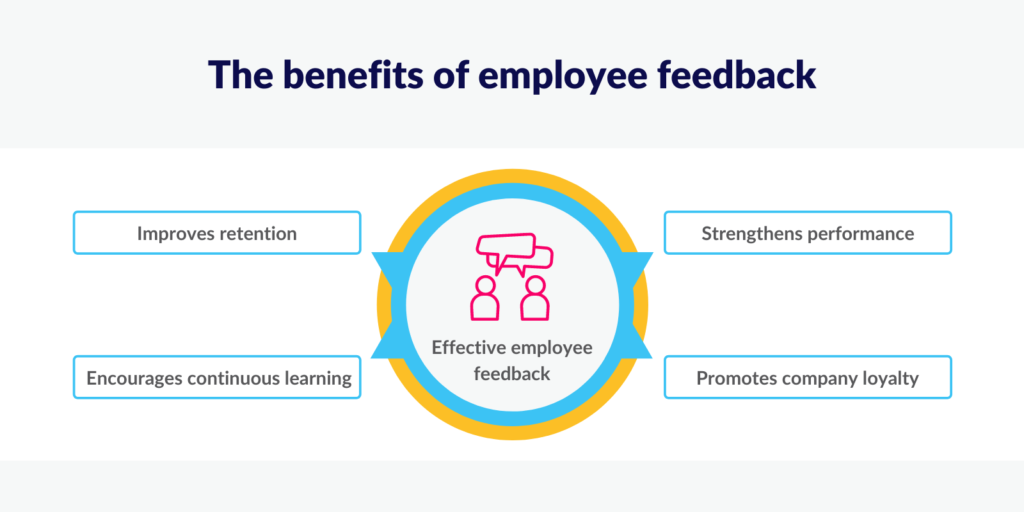
When delivered correctly, effective feedback can have the following advantages:
- Strengthening performance. Great feedback gives clear expectations. It helps your employees to stretch themselves in their roles, share their skills, and understand what they need to improve and how to achieve it.
- Promoting loyalty to the company. If you provide regular constructive feedback to help employees develop and grow, they’re much more likely to be loyal to your business.
- Improving retention. Loyal employees are less likely to seek work elsewhere. Constructive feedback in particular can help to reduce staff turnover, as your employees are confident that you want to nurture their career success.
- Encouraging continuous learning. Ongoing conversations which place a high value on constructive feedback help employees learn new skills on a daily basis. This in turn makes them more valuable assets for the company, capable of creating new strategies, products, and relationships.
How honest should you be?
The expression, “honesty is the best policy” might sound like a cliche, but sticking to this principle is important when delivering effective feedback. However, the way you approach honest feedback can make the difference between helping your team overcome challenges and causing them distress or despair.
To avoid the latter, real-time performance feedback needs to be framed with solutions in mind, given in the context of improving upon existing strengths. Negative feedback is less likely to be taken on board if it can be interpreted as a subjective opinion, or, even worse, a personal attack. As such, effective feedback should be backed by objective performance data.
Delivering positive feedback also poses potential issues which need to be understood. The article for the Harvard Business Review, How Leaders Can Get Honest, Productive Feedback, outlines the potential pitfall when delivering praise instead of positive feedback:
“For clarity, positive feedback is not the same as praise. Praise tells us someone is happy with us and thinks we are performing well. Praise sounds like: “Nice job!”; “You were great in that meeting.”; “Killer presentation!” While it feels good, praise does not give us enough information to understand what we are doing effectively so that we can repeat the behavior.”
We’ve established that negative feedback should be delivered honestly and with a view to presenting possible solutions to poor performance. This applies to positive feedback too. It’s important to frame positive evaluations in a way that places a spotlight on the specific behaviours which produce the best outcomes.
How to give feedback in a constructive way
There is no one-size-fits-all approach to delivering constructive feedback. Each employee responds differently, so it’s important for your managers and team leaders to understand the individual quirks and attitudes of each individual.
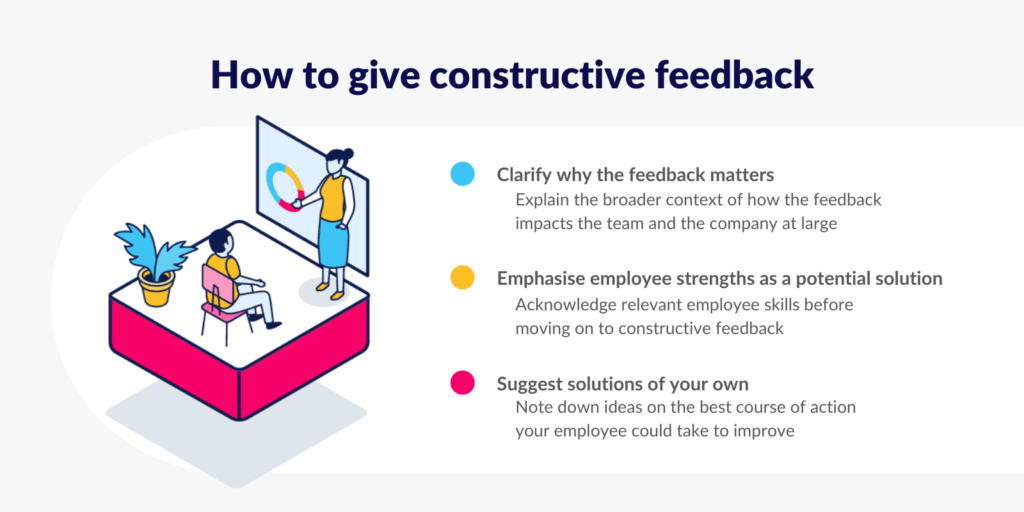
With that said, there are some useful rules of thumb you can follow that can help you to deliver constructive feedback as effectively as possible. When delivering constructive feedback, consider:
- Clarifying why the feedback matters. When dealing with under-performance or poor performance, you can address the individual’s actual performance. However, it’s important to explain the broader context of how this impacts their team and the company at large. Framing constructive feedback in this context helps employees to appreciate that it’s not just about them. They’re much more likely to address concerns if they understand the negative impact on colleagues they like and respect.
- Emphasise their strong points as a potential solution. Very few employees have no redeeming qualities. Acknowledging relevant employee skills through positive feedback, before moving on to constructive feedback, helps to set a positive tone.
- Suggest solutions of your own. Highlighting problems without any ideas about how they might be resolved is a far cry from constructive. Before delivering constructive feedback, note down ideas on the best course of action your employee could take to improve.

Use your One on Ones for feedback
Great feedback needs to be delivered in a timely manner. This is important whether you’re commending an employee for solid performance or providing constructive feedback when something goes wrong. As such, feedback needs to be part of a continuous process. Using regularly scheduled one2one sessions is essential for ensuring consistent feedback doesn’t fall by the wayside.
One2one check-in conversations can be quickly scheduled and managed through performance management software. All participants can view the agenda for a given meeting ahead of time, giving them ample time to prepare appropriate feedback or questions.
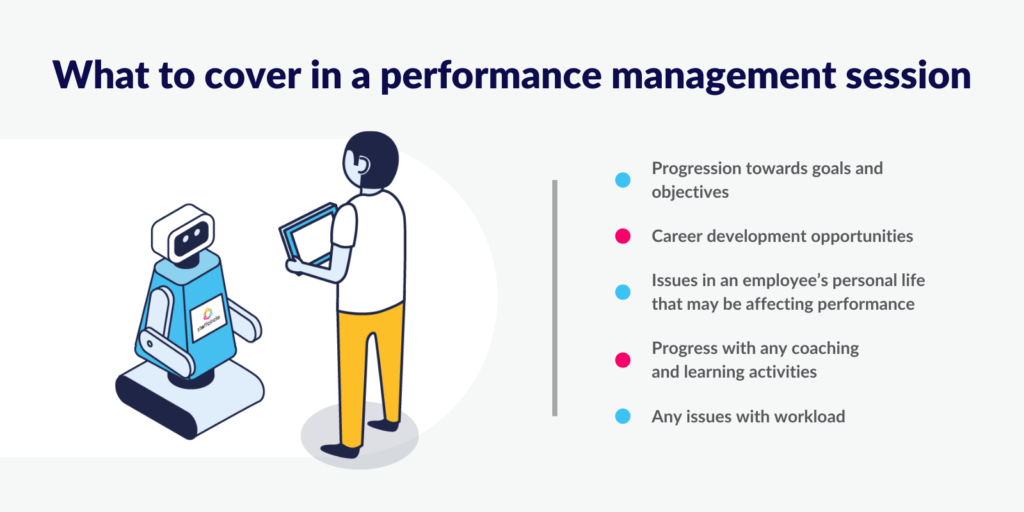
Performance management systems can also be used to track any notes and observations highlighted during the meetings. This gives both your managers and employees insights into any ongoing issues.
These sessions can cover a variety of topics, including:
- Progression towards goals and objectives
- Career development opportunities
- Issues in an employee’s personal life that may be affecting performance
- Progress with any coaching and learning activities
- Any issues with workload
It’s also important to ask the right questions when engaging in one2one feedback sessions. Here are some examples of great questions you can use or share with managers to get the most out of one2one sessions:
- Is the feedback you receive constructive and useful?
- How do you prefer to receive feedback?
- Do you feel as if you are praised for your good work and encouraged to perform better?
- Is there anything I can do as a manager to improve how I support your work?
- Is the feedback you receive constructive?
- Are you given enough constructive criticism?
- What have your previous managers done that you like?
- What do you like and dislike about my management style?
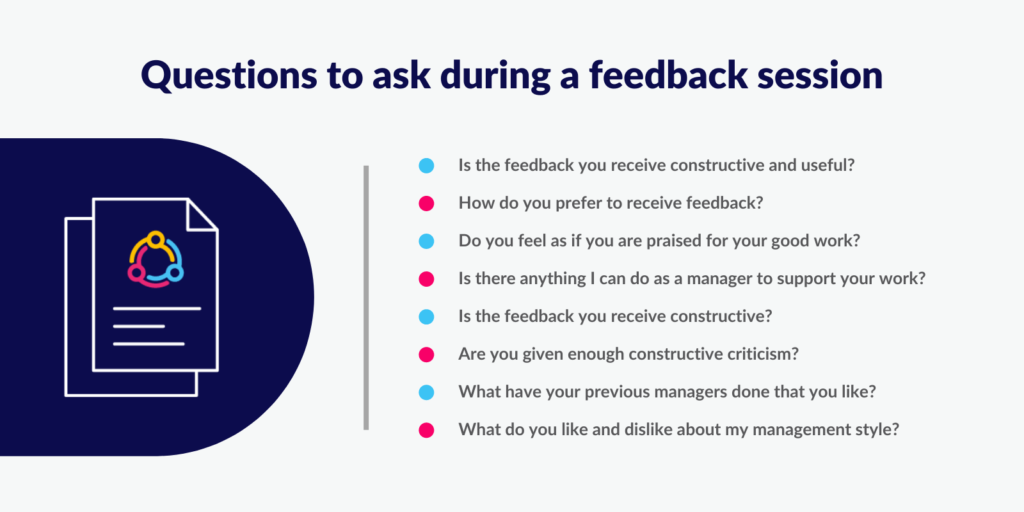
These questions can help your managers and team leaders to better engage in the feedback process with individual employees. They can also help to shed light on alternative feedback methods which you may have overlooked.
Boosting people’s confidence and ability
Well-delivered feedback should aim to deliver a positive outcome, whether the feedback itself is positive, constructive, or negative. At the heart of great feedback lies the intention of boosting your employee’s confidence, helping them to improve their abilities.
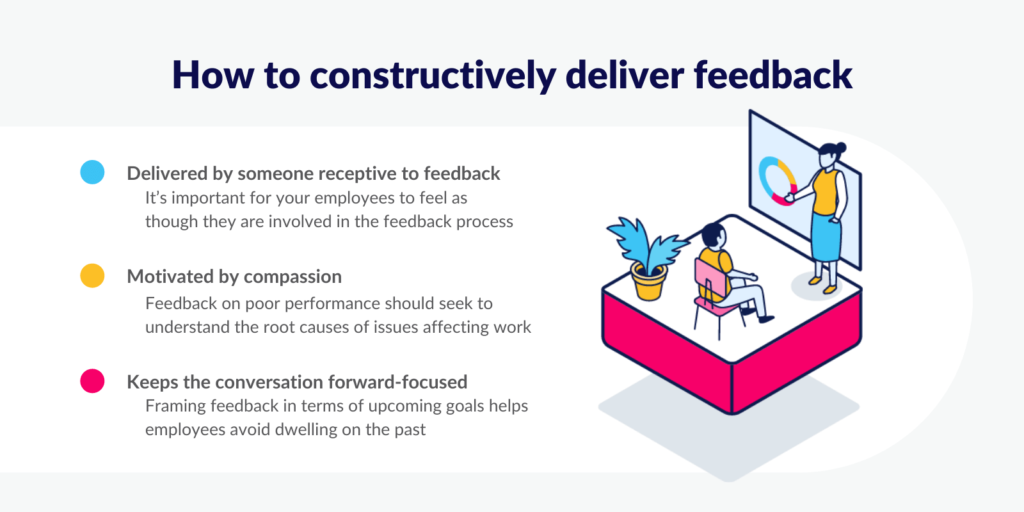
The feedback that achieves these outcomes:
- Is delivered by someone receptive to feedback themselves. It’s important for your employees to feel as though they are involved in the feedback process, rather than being lectured. The person delivering the feedback should be open to re-evaluation based on the employee’s input.
- Is motivated by compassion. Feedback on poor performance should seek to understand the root causes of issues affecting work. This helps employees gain the confidence they need to find a solution that benefits everyone.
- Keeps the conversation forward-focused. Framing feedback in terms of upcoming goals and objectives helps employees avoid dwelling on the past. Instead, it enables them to develop their skills while moving on to new challenges.
Creating a safe environment for top performers to flourish
A culture of open and honest feedback allows your best performers to flourish. Creating this effective culture, that values the right kind of feedback, is best achieved through company-wide adoption. Team leaders, direct reports, and upper management must be on board for feedback to be truly honest.
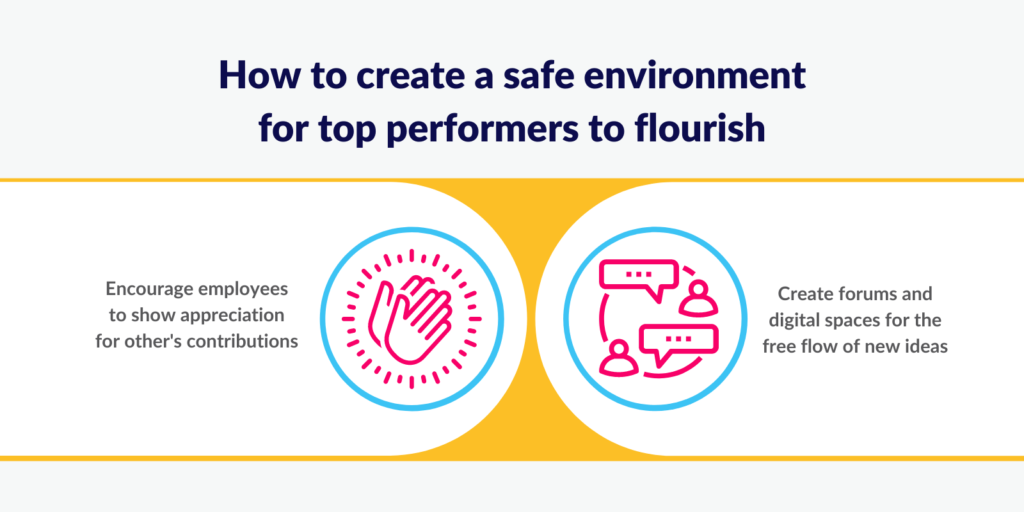
There are other strategies you can adopt to help foster a safe environment that understands the importance of well-being. Allowing employees to reach their true potential offers the most benefit to your business and success.
Encourage employees to show appreciation for one another’s contributions
Effective feedback shouldn’t be limited to the manager-to-report dynamic. Peer-to-peer feedback can have just as positive an impact on the working environment. This can be anything from a verbal commendation in the office, to implementing awards and recognition programs through your performance management software to encourage positive behaviours.
Create forums and digital spaces for the free flow of new ideas
Feedback doesn’t have to be formal to be effective. Creating spaces for casual conversations helps to improve the feeling of safety and an open culture. These spaces can be real office spaces such as recreation rooms for employees to relax and get to know their colleagues. Alternatively, intranet forums can help develop social connections and company engagement among a hybrid workforce.
4 ways to give feedback
There are several ways you can choose to approach feedback that will help you to give it the right way. Whether it’s praising great work or challenging an employee to up their game, there are ways to deliver the best results.
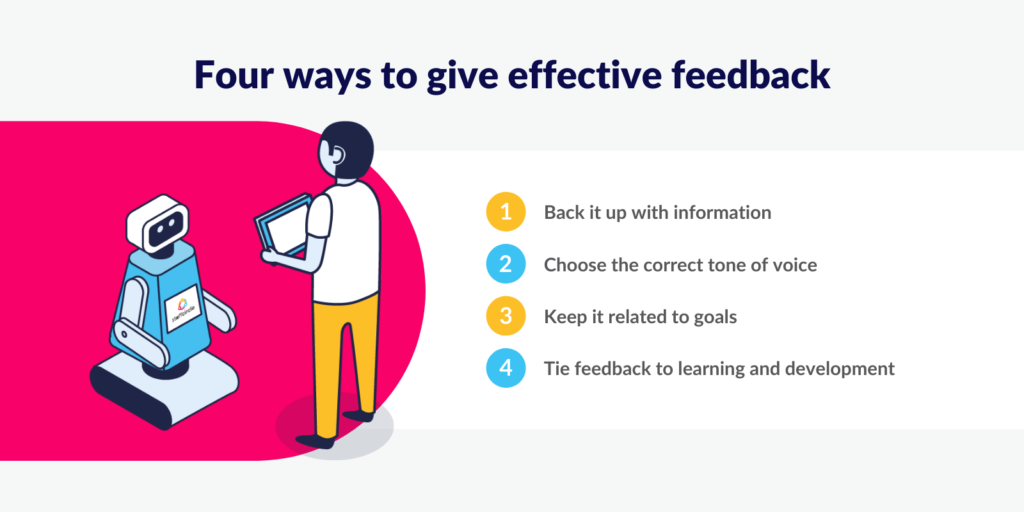
- Back it up with information. There should be no shortage of information available that you can use to back up feedback. Most companies use a range of software to track performance-related data, metrics, and other employee targets. Bring this information along when delivering feedback so employees can see precisely what went wrong – or right.
- Choose the correct tone of voice. How feedback is delivered can make a big difference in how it is received. If you’re frustrated as a manager because of repeated failures, take the time to set aside these feelings so you don’t come across as irritated or annoyed. On the flip side, if you’re ecstatic about their performance, let it show that’s the case in your tone.
- Keep it related to goals. While some performance-related feedback isn’t goal-related, most of it can be tied to the role and responsibilities of your employees. Keep the feedback focused on the task at hand, with an eye on how they can make improvements in the future.
- Tie feedback to learning and development. Feedback should be aimed toward helping an employee grow. As this article from TIME magazine that discusses how to give good feedback observes:
“The most profound and lasting benefit of sharing feedback with students or employees is the development of their awareness of their own learning. Having access to information about their performance creates opportunities for learners to recognize when they’ve made mistakes and figure out what to do to fix them. It also helps them to monitor their own motivation and engagement, and take proactive steps when they feel these flagging.”
In summary
Feedback is a powerful tool for encouraging employees to develop their skills, correct mistakes and deliver their A-game in your workplace. This guide should help you to set the right tone to make feedback an effective ongoing tool for optimal performance.





